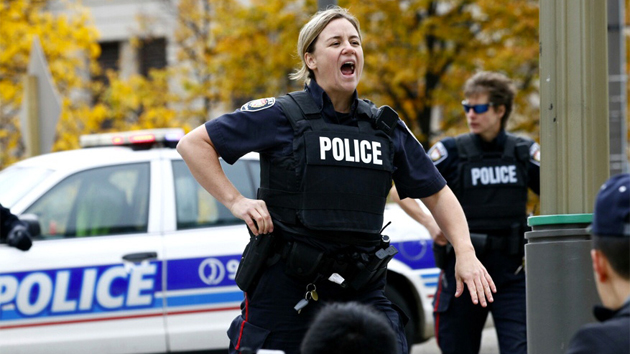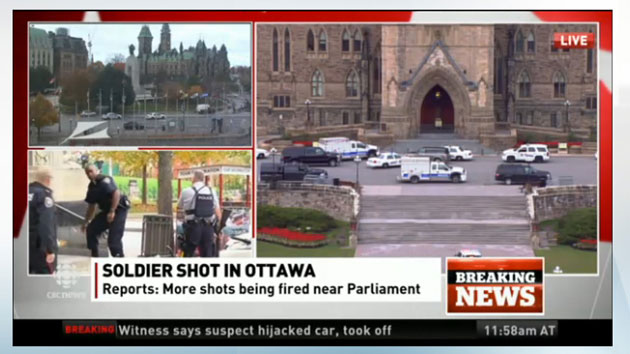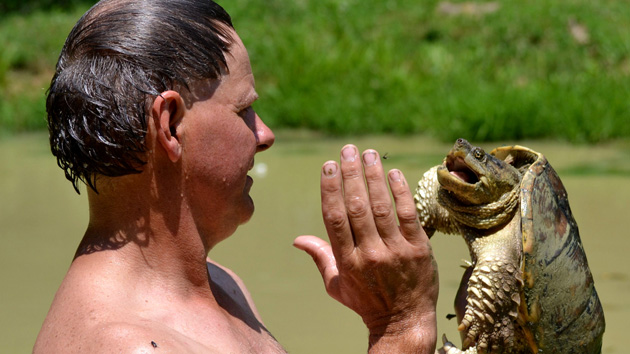Kevin Vickers, Canada’s sergeant at arms since 2006, is being heralded worldwide as a national hero after he reportedly shot and killed an armed assailant in the nation’s Parliament building Wednesday morning. It was a highly emotional moment when Vickers returned to Parliament today—watch the video above—and was greeted with an extended standing ovation. Witnesses are convinced that Vickers, 58, prevented a large-scale massacre in Ottawa. And though he has not yet spoken publicly about his actions (he’s notoriously modest), his record of public service is proof enough of his exceptional character.
Eight years ago, Vickers celebrated his election as the House of Commons’ top cop by traveling in style from Ottawa to New Brunswick on a brand new Harley. “As a gift, his two daughters bought him a vanity licence plate with the letters SGTATRMS,” wrote Bea Vongdouangchanh of The Hill Times. But his career began nearly three decades earlier as a member of the Royal Canadian Mounted Police (the “Mounties”), who are responsible for policing provincial and criminal cases while monitoring Canadian internal security.
The Mounties were convened in 1873, in part to monitor and deal with Americans who were trading with Native Americans in Canada—cheap whiskey for buffalo hides. Today, the force focuses on issues like organized crime and national security, and has jurisdiction in eight provinces, three territories, 184 aboriginal communities, and three international airports. Vickers signed up almost 40 years ago, and spent 29 years on the force—a true-blue local boy from small town Miramichi who moved up in the ranks over time.
In 2000, he was put in charge of the Burnt Church Crisis, a heated battle in which Canadian fishermen destroyed hundreds of indigenous people’s lobster traps. The Native lobstermen retaliated by trashing fish-processing plants. The Mounties were called in to deal with the tense standoff and resolved it peacefully thanks to Vickers’ “thorough assessment” and “measured response,” according to an account from a book on Canadian policing. In an interview with his hometown paper, Vickers credited his experience delivering milk in Burnt Church and Neguac during summer vacations as vital to his understanding the region’s people—which helped him deal with both sides of the crisis respectfully.
Vickers was also involved in several high-profile investigations involving murders, drug crimes, and a tainted Red Cross blood supply. By the end of his term with the Mounties, he held the title of chief superintendent.
In 2005, he joined the House of Commons as director of security operations, and a year later was elected sergeant at arms. From the start, Vickers led the charge on the development of Canada’s “bias-free policing strategy”—now a part of RCMP officer training—by reaching out to the Canadian Muslim community to discuss cultural sensitivity. He served a security guard for the Queen of Canada herself, and was awarded the Queen’s Jubilee Medal to “honor contributions and achievements made by Canadians,” according to an official fact sheet. He also received the Canada 125 Medal and the RCMP Long Service Medal. The United States has offered Vickers a commendation for his “Outstanding Contribution to Drug Enforcement.”
Vickers has remained humble despite his many plaudits—he insists he’s just doing his job. A 2011 feature on Vickers in The Globe and Mail describes how he defended the right of people to wear the kirpan—a ceremonial dagger carried by baptized Sikhs—in the National Assembly. In response, the World Sikh Organization hosted a dinner in his honor. He spoke with The Globe and Mail about why he stood up for the Sikhs:
“As we go forward, we should ask ourselves what Canada should be when it grows up…We have a long way to go before reaching adulthood. The seizure of the kirpans at the Quebec legislature last winter demonstrates the challenges that lay before us as we continue on this journey of sewing together the fabric of our nation with the thread of multiculturalism. Perhaps it would be beneficial for our country, as a nation, to define its core values. What are the core values of Canada, what makes up the soul and heart of our nation?…I told them [Canadian officials] that if they made me their sergeant-at-arms, there would be no walls built around Canada’s Parliamentary buildings…and the fact that you may wear your kirpans within the House of Commons proves there are no walls around Parliament and I have kept my promise.”












